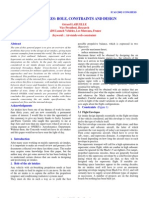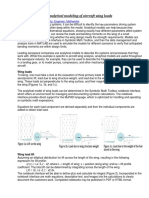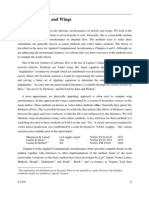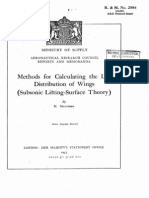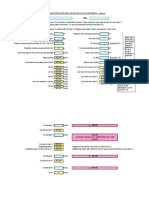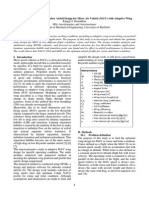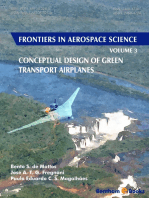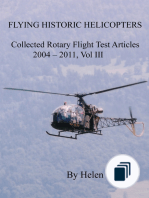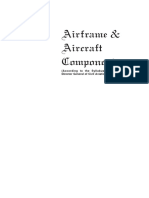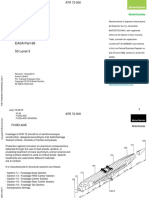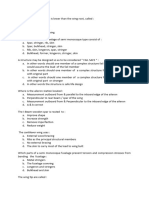0 ratings0% found this document useful (0 votes)
79 viewsAER621 Aircraft Structural Design Winter 2011
AER621 Aircraft Structural Design Winter 2011
Uploaded by
Jessica IngabireThe document discusses the major structural components of a conventional fixed-wing aircraft, including the wing, fuselage, empennage, engine mounts, and undercarriage. It describes how each component functions and bears loads. The wing supports weight and maneuvers while flying and the undercarriage supports weight while landing. The empennage provides stability and control. Modern structures use materials like aluminum alloys, steel alloys, titanium alloys, and composites.
Copyright:
Attribution Non-Commercial (BY-NC)
Available Formats
Download as PDF, TXT or read online from Scribd
AER621 Aircraft Structural Design Winter 2011
AER621 Aircraft Structural Design Winter 2011
Uploaded by
Jessica Ingabire0 ratings0% found this document useful (0 votes)
79 views25 pagesThe document discusses the major structural components of a conventional fixed-wing aircraft, including the wing, fuselage, empennage, engine mounts, and undercarriage. It describes how each component functions and bears loads. The wing supports weight and maneuvers while flying and the undercarriage supports weight while landing. The empennage provides stability and control. Modern structures use materials like aluminum alloys, steel alloys, titanium alloys, and composites.
Original Title
Week_1_Intro
Copyright
© Attribution Non-Commercial (BY-NC)
Available Formats
PDF, TXT or read online from Scribd
Share this document
Did you find this document useful?
Is this content inappropriate?
The document discusses the major structural components of a conventional fixed-wing aircraft, including the wing, fuselage, empennage, engine mounts, and undercarriage. It describes how each component functions and bears loads. The wing supports weight and maneuvers while flying and the undercarriage supports weight while landing. The empennage provides stability and control. Modern structures use materials like aluminum alloys, steel alloys, titanium alloys, and composites.
Copyright:
Attribution Non-Commercial (BY-NC)
Available Formats
Download as PDF, TXT or read online from Scribd
Download as pdf or txt
0 ratings0% found this document useful (0 votes)
79 views25 pagesAER621 Aircraft Structural Design Winter 2011
AER621 Aircraft Structural Design Winter 2011
Uploaded by
Jessica IngabireThe document discusses the major structural components of a conventional fixed-wing aircraft, including the wing, fuselage, empennage, engine mounts, and undercarriage. It describes how each component functions and bears loads. The wing supports weight and maneuvers while flying and the undercarriage supports weight while landing. The empennage provides stability and control. Modern structures use materials like aluminum alloys, steel alloys, titanium alloys, and composites.
Copyright:
Attribution Non-Commercial (BY-NC)
Available Formats
Download as PDF, TXT or read online from Scribd
Download as pdf or txt
You are on page 1of 25
Aircraft Structural Design W2011
AER621 Aircraft Structural Design
Winter 2011
Aircraft Structural Design W2011
The Figure above reveals the complexity of today's large
commercial airliners.
Aircraft Structural Design W2011
The major parts of a conventional fixed-wing aircraft are
the wing, fuselage, empennage (tail), engine mounts, and
undercarriage (landing gear).
Aircraft Structural Design W2011
Most of the structure is covered by a thin skin, which
gives the airplane its streamlined aerodynamic shape
while helping to distribute a major portion of the internal
loads.
In flight, the wing supports the weight of the airplane
(including that of the wing itself) plus maneuvering loads
and gust loads. On the ground, landing loads and the
weight of the airplane at rest are borne entirely by the
undercarriage, the main wheels of which may be located
in the wing, which thereby repeats its airborne load-
bearing role.
Aircraft Structural Design W2011
The horizontal tailplane with its moving elevator and the
vertical tailplane (fin) with its pivoting rudder provide
longitudinal and directional stability and control, in
combination with the ailerons on the outboard trailing
edges of the main wing.
Since the mid-1950s, supersonic military airplanes have
been equipped with a one-piece, all-moving horizontal
tailplane with no elevator. All-moving vertical fins have
also been employed (e.g., in the North American A-5
Vigilante, the Mach 3-plus Lockheed SR-71 Blackbird,
and the Lockheed F-1l7A Night Hawk stealth fighter).
Aircraft Structural Design W2011
In addition to ailerons, the wing may have movable
trailing-edge flaps and leading-edge slats to increase lift
(and therefore drag) at low speeds, as well as spoilers to
"kill" lift (after touchdown, for example).
Delta-wing aircraft usually have no horizontal tail, and
the elevons on the trailing edge of the delta planform
serve the dual role of aileron and elevator, as well as flap.
In general, Elevons are aircraft control surfaces that
combine the functions of the elevator (used for pitch
control) and the aileron (used for roll control)
Aircraft Structural Design W2011
Engines may be mounted on the wings, on the fuselage,
or both. Propellers are usually placed in the "tractor"
position, ahead of the piston or turbine power unit.
Notable exceptions include the giant Consolidated-Vultee
B-36 Peacemaker and the all composite Beech/Raytheon
Starship previously discussed.
Jet engines (efficient turbofans nowadays) are either
housed within the aft fuselage (most military fighters) or
mounted on the a/c wing and/or aft fuselage (commercial
and general aviation jets). With few exceptions, wing-
mounted jet engines on modern aircraft are slung beneath
the wing in streamlined nacelles.
Aircraft Structural Design W2011
The major structural elements of a conventional
semimonocoque fuselage are the transverse frames and
the longitudinal stringers.
Aircraft Structural Design W2011
The skin is attached (usually riveted) to both, and frames
and stiffeners may themselves be fastened together where
they intersect. Bulkheads are major transverse members
that are more massive than a typical frame.
Aircraft Structural Design W2011
Pressure bulkheads fill the entire fuselage cross section.
Aircraft Structural Design W2011
Primary longitudinal load-bearing members are known as
longerons. Large low-wing aircraft also have a keelson, a
massive longeron that runs along the bottom of the
fuselage. Its purpose is to transmit bending loads across
the central gap created by the landing gear wells and the
wing carry-through structure.
Aircraft Structural Design W2011
Bonded, bolted or riveted doublers or frames surround
cutouts (e.g., windows and doors) to pick .up and
transmit loads that would otherwise have been carried
across the opening by the absent structure.
Aircraft Structural Design W2011
Where the fuselage of a large transport contains mostly
empty space, that of a typical modern military jet is
crammed with engines, fuel cells, avionics, weaponry,
and other gear. All of this must be accessed through
numerous removable panels and access doors- so many,
in fact, that a modem fighter fuselage cannot be
considered as semimonocoque.
Aircraft Structural Design W2011
Ribs and spars are the major internal structural
components of a wing. Like fuselage frames, the ribs
define the shape of the attached envelope of skin, which
is anchored as well to many spanwise stringers
(stiffeners) on the upper and lower surfaces.
Aircraft Structural Design W2011
Wing spars play much the same role as longerons in the
fuselage, transmitting most of the bending load arising
from the wing's support of the aircraft's weight. The
vertical webs of the spars, in combination with the wing
cover skins, act as torque boxes to resist the twist that
also accompanies lift. The stiffeners pick up some of the
bending load in both the wing and the fuselage, but their
primary purpose is to aid the ribs and frames in stiffening
the skin against buckling. Spars, ribs, and stringers also
comprise the substructure of horizontal and vertical
stabilizers.
Aircraft Structural Design W2011
The landing gear ranks as one of the substructures most
crucial to aircraft performance during the periods
between touchdown and takeoff. Retractable landing gear
are among the most complex of the mechanical systems
on a modem airplane.
Aircraft Structural Design W2011
The landing gear must be able to absorb several times the
entire gross weight of the airplane-without undue shock
to the airframe or its contents-while comprising less than
10 percent of the structural weight.
Furthermore, it must quickly fold up into a compact
space in the wing or fuselage for storage during flight
and must as quickly and reliably deploy for landing. A
key structural component of a landing gear is an
oleopneumatic shock absorber, or oleo strut, which is
there to ease the loads on the airframe during landings
and to cushion impact.
Aircraft Structural Design W2011
Corrosion protection-a matter of concern throughout an
airframe-is clearly required for the undercarriage.
The landing gear attachment points (spars and bulkhead
ribs on the wing, frames and beams in the fuselage) must
be "hard," that is, designed to absorb the 'concentrated
load and distribute it efficiently into the less massive
surrounding structure.
Aircraft Structural Design W2011
The same is true where engines are attached to the
airframe. These structures must resist the weight and
moment of the powerplant, as well as the thrust, torsion,
and vibration it produces. As with landing gear, there is a
huge variety of engine mounts. The design clearly
depends on the kind of engine it supports (piston,
turboprop, turbojet) and the position where the engine is
mounted. Jet engines are invariably attached to the
airframe at just three points, by means of a support
system that is statically determinate. This ensures that
airframe deflections cannot transfer to the engine and that
thermal expansion of the engine can occur freely. It also
means the engine can be removed and installed quickly.
Aircraft Structural Design W2011
Engines mounted inside the fuselage attach directly to the
fuselage framework via links and trunnions. Those
mounted below the wings or on the aft fuselage are
housed in protective streamlined nacelles and are
Aircraft Structural Design W2011
fastened to pylons that in turn are joined to the wing or
fuselage structure. The pylons are builtup, stiffened-web
structures, or truss structures, or perhaps a combination
of the two.
Aircraft Structural Design W2011
Finally, a quick word on aircraft materials. The main
groups of materials used in modern aircraft construction
have been aluminum alloys and steel alloys with, more
recently, titanium alloys, and fiber-reinforced
composites. In gas turbine engine design, titanium alloys
are used in the early stages of a compressor while nickel-
based alloys or steels are used for the hotter later stages.
Aircraft Structural Design W2011
Aircraft Structural Design W2011
Aircraft Structural Design W2011
You might also like
- Understanding The Lamination ProcessDocument12 pagesUnderstanding The Lamination ProcessSamora Tooling Engineer100% (1)
- Vortex Methods Theory and Practice by Georges Henri CottetDocument13 pagesVortex Methods Theory and Practice by Georges Henri CottetLam Trinh Nguyen100% (1)
- Lab 3 TutorialDocument53 pagesLab 3 TutorialAkshay100% (1)
- Splice JointsDocument2 pagesSplice JointsManoj ManoharanNo ratings yet
- Aircraft Design Project 2 PDFDocument71 pagesAircraft Design Project 2 PDFVignesh50% (2)
- Unit 4 Aircraft StructuresDocument12 pagesUnit 4 Aircraft Structurespiravi66No ratings yet
- Wing Rib Stress Analysis and Design OptimizationDocument5 pagesWing Rib Stress Analysis and Design OptimizationNeeraja ManemNo ratings yet
- Lesson 5 MAJOR STRUCTURE STRESSESDocument4 pagesLesson 5 MAJOR STRUCTURE STRESSESjeevan basnyatNo ratings yet
- SOLO 210 - Fly CastelluccioDocument33 pagesSOLO 210 - Fly CastelluccioadambmwNo ratings yet
- 1938 Librascope ManualDocument12 pages1938 Librascope ManualDenes PappNo ratings yet
- A Generalized Vortex Lattice Method For Subsonic and Supersonic Flow Applications - Nasa Contractor Report PDFDocument382 pagesA Generalized Vortex Lattice Method For Subsonic and Supersonic Flow Applications - Nasa Contractor Report PDFMB-RP100% (1)
- Air IntakeDocument16 pagesAir IntakeDr.S.RamamurthyNo ratings yet
- Analytical Modeling of Aircraft Wing LoadsDocument5 pagesAnalytical Modeling of Aircraft Wing LoadsrichardchwaNo ratings yet
- Optimization: of Joined-Wing AircraftDocument10 pagesOptimization: of Joined-Wing AircraftSagar KulkarniNo ratings yet
- Index: Aircraft Design Project - IIDocument56 pagesIndex: Aircraft Design Project - IIRohit MunaNo ratings yet
- Experimental and Theoretical Assessment of Aerodynamic and Stability Derivatives of A Subscale AircraftDocument6 pagesExperimental and Theoretical Assessment of Aerodynamic and Stability Derivatives of A Subscale AircraftIgor Mayer SoaresNo ratings yet
- Lift Line TheoryDocument19 pagesLift Line TheoryMuzakkir Sharieff100% (1)
- Mason - Transonic Aerodynamics of Airfoils and Wings (DRAFT)Document22 pagesMason - Transonic Aerodynamics of Airfoils and Wings (DRAFT)Raphael Felipe Gama RibeiroNo ratings yet
- A02 External LoadsDocument17 pagesA02 External LoadsNarendra PalandeNo ratings yet
- Wing IntroductionDocument15 pagesWing IntroductionRafli SaputraNo ratings yet
- Rana Anurag Aeromodelling Lab Final Report 08Document18 pagesRana Anurag Aeromodelling Lab Final Report 08Anurag RanaNo ratings yet
- Soyuz Users Manual CSGDocument233 pagesSoyuz Users Manual CSGNatalia OrtizNo ratings yet
- Aircraft Flight Dynamics 2015 - 04 - 13 PDFDocument34 pagesAircraft Flight Dynamics 2015 - 04 - 13 PDFWii RodriguezNo ratings yet
- Thesis NC HeerensDocument123 pagesThesis NC HeerensJoel E ValenciaNo ratings yet
- Introduction To Aerospace Vehicles: TopicsDocument42 pagesIntroduction To Aerospace Vehicles: TopicsMukeshPatelNo ratings yet
- Aircraft Design Project-Ii: Design of Eight Seater Business JetDocument25 pagesAircraft Design Project-Ii: Design of Eight Seater Business JetUma shreeNo ratings yet
- Wing Flutter Analysis2Document23 pagesWing Flutter Analysis2Muthu VelNo ratings yet
- Conceptual Design Methodology For A BWB PDFDocument276 pagesConceptual Design Methodology For A BWB PDFJose Luis Sarango DiazNo ratings yet
- ACP 116 UNIT 13 Airframes: Chapter 7: UndercarriageDocument36 pagesACP 116 UNIT 13 Airframes: Chapter 7: UndercarriageAnonymous 84PIIHNo ratings yet
- Astro320 Problem Set3 SolutionsDocument5 pagesAstro320 Problem Set3 SolutionsMike Rowen BanaresNo ratings yet
- Aerodynamic Calculation of Subsonic Airfoils - FINAL PDFDocument8 pagesAerodynamic Calculation of Subsonic Airfoils - FINAL PDFPaulo LindgrenNo ratings yet
- An Overview of Landing Gear Dynamics-NasaDocument20 pagesAn Overview of Landing Gear Dynamics-Nasaritesh1986No ratings yet
- Subsonic Airfoils and WingsDocument50 pagesSubsonic Airfoils and WingsSaravana Kumar LakshmananNo ratings yet
- Mark Flanner - An Analysis of The Central Fuel Tank Explosion of TWA Flight 800Document18 pagesMark Flanner - An Analysis of The Central Fuel Tank Explosion of TWA Flight 800YamveaNo ratings yet
- Shear Force and Bending Moment Diagrams Due To Loads Along Chordwise DirectionDocument11 pagesShear Force and Bending Moment Diagrams Due To Loads Along Chordwise DirectionERÃŋkîtÇhàñdràkàr100% (1)
- Drag Reduction in An AirplaneDocument14 pagesDrag Reduction in An AirplaneDhruvNo ratings yet
- XFLR5 and Stability AnalysisDocument70 pagesXFLR5 and Stability AnalysisPravin PrajapatiNo ratings yet
- Flutter and Directional Stability of AircraftDocument12 pagesFlutter and Directional Stability of AircraftdaliadavidkNo ratings yet
- Multhopp MethodDocument98 pagesMulthopp MethodmartinsandovalandresNo ratings yet
- Conceptual Design of A Business Jet Airc PDFDocument6 pagesConceptual Design of A Business Jet Airc PDFHamza TurhanNo ratings yet
- Advisory Circular: Aircraft Weight and Balance ControlDocument71 pagesAdvisory Circular: Aircraft Weight and Balance Controljake_calderónNo ratings yet
- Trim SolutionDocument40 pagesTrim Solutionendoparasite100% (1)
- Tail Design and SizingDocument7 pagesTail Design and SizingNikhil SethiNo ratings yet
- CS-VLA Appendix A Flight Envelope and Check LoadsDocument10 pagesCS-VLA Appendix A Flight Envelope and Check LoadsKIRU SILVIU100% (1)
- Aerodynamics Design AssignmentDocument11 pagesAerodynamics Design AssignmentRanggi Sahmura100% (1)
- Design ND Optimization Using CFDDocument29 pagesDesign ND Optimization Using CFDKrishna TejaNo ratings yet
- 4749d1256688021 RR Merlin Build CrankDocument1 page4749d1256688021 RR Merlin Build CrankRicky EdwardsNo ratings yet
- Simulation of Aircraft Landing Gear Dynamics Using Flexible MultibodyDocument10 pagesSimulation of Aircraft Landing Gear Dynamics Using Flexible MultibodyElvindinata100% (2)
- Lifting Line Theory Tutorial ExampleDocument17 pagesLifting Line Theory Tutorial ExampleGareth VioNo ratings yet
- Naca TN 3911Document30 pagesNaca TN 3911teuapNo ratings yet
- Airfoil CalculatorDocument12 pagesAirfoil Calculatortolomeo10100% (1)
- Small Unmanned Aircraft: Theory and PracticeFrom EverandSmall Unmanned Aircraft: Theory and PracticeRating: 4.5 out of 5 stars4.5/5 (2)
- Unmanned Aircraft SystemsFrom EverandUnmanned Aircraft SystemsElla AtkinsNo ratings yet
- A Much Unsung Hero, The Lunar Landing Training Vehicle: And Other NASA RecollectionsFrom EverandA Much Unsung Hero, The Lunar Landing Training Vehicle: And Other NASA RecollectionsRating: 5 out of 5 stars5/5 (1)
- Sub Module 13.2 Airframe Structures - General ConceptsDocument30 pagesSub Module 13.2 Airframe Structures - General ConceptsteacherNo ratings yet
- Tla 1Document16 pagesTla 1Cristian SanchezNo ratings yet
- Aircraft Structural Considerations Fall 2008Document54 pagesAircraft Structural Considerations Fall 2008Johan Louie Rayos100% (2)
- Summary of Semimonocoque and Monocoque DesignDocument5 pagesSummary of Semimonocoque and Monocoque Designperkasagagah42100% (2)
- Research and Application of MAEU UAVsDocument20 pagesResearch and Application of MAEU UAVsThein Than LinNo ratings yet
- Aircraft Construction and MaterialsDocument4 pagesAircraft Construction and Materialsgalaxy_hypeNo ratings yet
- Aircraft Construction and Materials1Document4 pagesAircraft Construction and Materials1govindarajan017No ratings yet
- Preliminary Design Approach of The Wing BoxDocument3 pagesPreliminary Design Approach of The Wing BoxWhyDirgantara IDNo ratings yet
- UNIT-1 Aircraft Structures-I Structure Layout of Airplane: Airframe UnitsDocument11 pagesUNIT-1 Aircraft Structures-I Structure Layout of Airplane: Airframe UnitsDhruvNo ratings yet
- Aircraft StructuresDocument3 pagesAircraft StructuresAayush BansalNo ratings yet
- Overview of The Aircraft Design Process V40Document277 pagesOverview of The Aircraft Design Process V40Brian Xistos100% (3)
- Airframe and Aircraft Components PDFDocument168 pagesAirframe and Aircraft Components PDFPravin HandeNo ratings yet
- Shear Force and Bending Moment Diagrams Due To Loads Along Chordwise DirectionDocument11 pagesShear Force and Bending Moment Diagrams Due To Loads Along Chordwise DirectionERÃŋkîtÇhàñdràkàr100% (1)
- Task NTM NOVO AIR ATR72Document13 pagesTask NTM NOVO AIR ATR72Duy Phan KiếnNo ratings yet
- FuselagesDocument14 pagesFuselagesBechir FoudhailiNo ratings yet
- 1 Roles of Aircraft StructuresDocument32 pages1 Roles of Aircraft StructureszaidNo ratings yet
- AE 533 Lecture 1Document15 pagesAE 533 Lecture 1sultan aliNo ratings yet
- 4 StructureDocument101 pages4 StructureDiego Contreras ArriagadaNo ratings yet
- Questions ATA 51Document22 pagesQuestions ATA 51huynhnhuNo ratings yet
- C. T. Sun Mechanics of Aircraft StructuresDocument192 pagesC. T. Sun Mechanics of Aircraft StructuresYogendraKumarNo ratings yet
- Airframe StructuresDocument23 pagesAirframe StructuresARQUAM WAHAJNo ratings yet
- Wing PlanformDocument12 pagesWing PlanformBogdan Ionut HruscaNo ratings yet
- Training Manual: EASA Part-66 53 Level 3Document22 pagesTraining Manual: EASA Part-66 53 Level 3Luis Enrique La Font FrancoNo ratings yet
- Aircraft Structure Soal 3Document7 pagesAircraft Structure Soal 3FAQIH MuhamadNo ratings yet
- General Loads On Aircraft StructureDocument42 pagesGeneral Loads On Aircraft StructureSunil Panwar86% (7)
- 5 Classic Flying Models-OpenDocument90 pages5 Classic Flying Models-OpenDaniel Sabolek67% (3)











